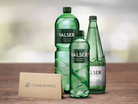How Climeworks DAC Tech Carbonates Coca-Cola’s Vasler Water

In Switzerland, an innovative company is quite literally pulling carbon dioxide out of thin air and putting it into sparkling water.
Climeworks, a pioneer in direct air capture (DAC) technology, has found a unique way to combat climate change while adding fizz to one of Coca-Cola’s beverages, Valser sparkling mineral water.
By partnering with Coca-Cola Hellenic Bottling Company (HBC) in Switzerland, Climeworks is not only removing CO₂ from the atmosphere, but ensuring it is reused in an industry where CO₂ plays a key role in drink carbonation, dispensing and packaging.
Climeworks’ climate technology and its applications will be celebrated in the inaugural edition of ClimateTech Digital, set to launch in November.
How does Climeworks capture CO₂?
So what’s the science behind the bubbles?
Climeworks’ DAC technology is deceptively simple in concept but revolutionary in practice.
Large fans draw ambient air into collector units, where specially designed filters capture CO₂ molecules. Once the filters are saturated, they are then heated to about 100°C, which releases concentrated CO₂ that can be collected for various uses — like in drinks, as profiled here.
“We are very happy to be entering the beverage market in Switzerland together with Coca‑Cola HBC Switzerland, attaching importance to social and environmental aspects of business,” Climeworks Co-Founder and Co-CEO Dr Christoph Gebald said when Climeworks and Coca-Cola HBC Switzerland first formed the partnership.
“Coca‑Cola HBC Switzerland has been an exceptionally supportive partner and invaluable in moving the application of DAC in the beverage industry forward — something we are very thankful for.”
Fellow Co-Founder and Co-CEO Jan Wurzbacher added: “We are excited by the chance to collaborate with a beverage industry leader as part of our overarching goal of capturing 1% of global CO₂ emissions by 2025.”
But it’s not just the drinks space where Climeworks is focusing its energy. In 2021, Climeworks launched Orca, the world's largest direct air capture and storage facility in Iceland. The site is capable of removing up to 4,000 tons of CO₂ annually.
The company is also partnering with other industries to find innovative uses for captured CO₂, from enhancing greenhouse crop growth to producing carbon-neutral fuels — a further display of captured CO₂’s potential in different industries.
CO₂ in the beverage industry
While using captured CO₂ in one of Coca-Cola’s many products may seem like quite a small part of the beverage giant’s operations — and even smaller when you look at the industry as a whole — using captured CO₂ for drink carbonation is a significant use case and proof of concept for DAC tech.
Climeworks’ partnership with Coca-Cola demonstrates that air-captured CO₂ can meet the stringent quality standards of the food and beverage industry.
With around 70% of the CO₂ produced in the US used by the food and drinks industry and shortages in industry-safe CO₂ meaning food and drink companies are often without sufficient supply, Climeworks’ technology could grow to be a solution for one of the industry’s biggest challenges.
As an added bonus, this application helps offset some of the costs associated with DAC technology, making it more economically viable. As Climeworks scales up its operations, the potential for carbon removal increases dramatically.
Sipping toward sustainability
While carbonating water alone won't solve the climate crisis, Climeworks’ partnership with Coca-Cola HBC in Switzerland demonstrates the potential for innovative solutions to make a real difference.
As we continue to seek and pioneer innovative ways to reduce carbon footprint among some of the world’s worst-offending industries, technologies like DAC offer a glimmer of hope – as well as a refreshing twist to sparkling beverages.
******
Receive the next edition of ClimateTech Magazine by signing up for its newsletter.
As part of this portfolio, make sure you check out Sustainability Magazine and also sign up to our global conference series - Sustainability LIVE.
Also check out our Sister Brand, Energy Digital.
******

